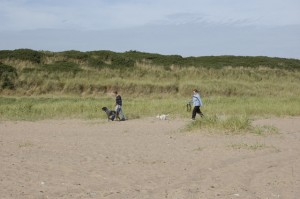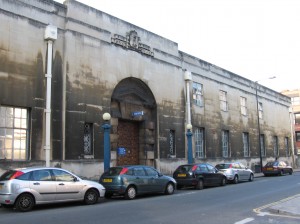On December 17th, 2010, Joanna Yeates disappeared. She was a 25-year-old landscape architect in Bristol, UK. Her absence was discovered on the 19th, when her boyfriend returned from a weekend away and noticed that the car hadn’t been moved and the cat hadn’t been fed. When he called her cell phone, he heard it ringing in the pocket of a coat hanging in the flat.
He called police (the Avon & Somerset Constabulary). A publicity blitz and manhunt began. On Christmas Day, a couple walking their dogs found Yeate’s snow-covered, strangled body lying near the entrance to a quarry. Press coverage rampaged on, with everything the tabloid press could discover about “Jo.”
On December 30th, police arrested Yeates’s landlord, Christopher Jefferies, who lived in the building. They held and questioned him while they searched his flat. Another tenant, Vincent Tabak, called police to say he’d seen Jefferies’s car facing one way the evening of the 17th, and another way in the morning (suggesting he had driven somewhere in the night). Police got a 12-hour extension to hold Jefferies, then a 24-hour extension. Finally he was allowed to post bail on January 1st 2011.
The investigation roared forward. Mass DNA screening was proposed. A dramatic recreation of the crime was broadcast on the BBC’s Crimewatch, resulting in hundreds of calls from the public.
Many news outlets went wild about Jefferies, the man who had been arrested and released. All they had was innuendo, but they did wonders with that.
They hinted he was a Peeping Tom. Maybe gay – or bisexual. A “nutty professor type.” He was 65 and was a retired English teacher, so they asked former students about him. The blog CrashBangWallace collected some of the half-witted innuendo. For example… he talked funny. He was an oddball, weird, a loner, posh, creepy, lewd, strange, liked poetry – but not cars or sports. A loner but ALSO a meddler. “An only child who never married.” Somebody said he was obsessed with Christina Rossetti.
(Rossetti. Oh yes. Didn’t she write about… death? Isn’t she… dead? …Thought so.)
As a result, many people figured Jefferies was the murderer, and only out on bail because police hands were tied, because they needed more evidence. Jefferies is a man of “distinctive appearance” and his picture was all over the place. He didn’t dare go home. “…[F]or a period after I was released I was effectively under house arrest and went from friends to friends rather as if I were a recusant priest at the time of the Reformation…, going from safe house to safe house,” he later said. Weirdly.
After a few weeks, on January 20th, police arrested Vincent Tabak, the tipster who’d called about suspicious movements of Jefferies’ car. Press coverage switched focus to Tabak, a Dutch engineer. He was described as a “loner,” although he lived with his girlfriend. (I think I’m kind of a loner myself. Come and get me, coppers.) His parents said “We saw what happened to the landlord and don’t want to see that happen to our lovely Vincent.”
Despite arresting Tabak, police did not release Jefferies from bail until March 5. This suggested that they might still be investigating his possible guilt. He continued to live a “hole-in-corner” life, never going home, with some friends proposing that he change his appearance for protection against media harassment.
Tabak said he was innocent. He said DNA linking him to the body was a frame-up. But then he told a chaplain that he’d killed Yeates and would change his plea. Although the chaplain had told Tabak they were talking “in confidence,” he decided that Tabak’s confession was “not a religious confession,” and passed it on.
Tabak pled guilty to manslaughter, not murder. He said Yeates had invited him to have a drink, and made a “flirty comment.” (That lascivious come-on, as reported by Tabak, was a reference to a pet: “The cat went into places where it shouldn’t go. A bit like me.”) He tried to kiss her. She screamed. To make her stop he squeezed her neck “for about 20 seconds.” She dropped dead. He panicked. He bundled her body into the boot (trunk) of his car, called his girlfriend and said he was bored, went to the store to pick up beer and snacks, dumped the body, and met his girlfriend.
He was convicted of murder, and given a life sentence.
Where’s the apology in all this? Tabak uttered a manslaughter-but-not-murder apology, directed to Yeates’s parents. “I was responsible for her death. I’m so sorry.”
Since her parents said they wished Tabak could have gotten the death penalty, and hope “he spends the rest of his life incarcerated where his life is a living hell, being the recipient of all evils, deprivations and degradations that his situation can provide,” we’ll say that the apology was not accepted.
Tabak also mentioned his try at framing his landlord. “I shouldn’t have said that about Chris Jefferies.”
Feeble apologies from murderers hoping for mercy aren’t notable. But there are other, more interesting apologies in this case. Chris Jefferies sued six newspapers that portrayed him as a crazy sicko. He won “substantial” damages from them all.
In addition, the Attorney General of England and Wales charged the Mirror and the Sun with violating the Contempt of Court Act 1981, which says among other things, that it is criminal contempt of court to publish things that run a real risk of seriously impairing “the course of justice” in active proceedings. “These two newspapers completely lost the plot,” said the Attorney General. “They engaged in a feeding frenzy.” They were fined £50,000 and £18,000, on the grounds that “the vilification of a suspect under arrest is a potential impediment to the course of justice.”
Later, at the Leveson Inquiry, a public examination of British press practices (main focus: phone-hacking), Mirror editor Richard Wallace took the opportunity to discuss the way the Mirror had treated Jefferies. “We obviously caused him and his nearest and dearest great distress which I regret, personally, greatly and I regard it as a black mark on my editing record.”
Okay, but it would be nice if Jefferies also heard your personal regrets personally.
Wallace also made the defense that the Mirror‘s coverage should be taken in the context of police briefings which were off the record, but in which the police seemed certain that “Mr Jefferies was their man”.
Colin Port, chief constable of Avon and Somerset at the time in question, said that was an “outrageous” claim and it did not either happen. Even if it did, there’s still that course of justice thing.
This September, Jefferies received a letter of apology from the chief constable of Avon and Somerset, Nick Gargan. It said that while they still felt his initial arrest was appropriate, they caused him “hurt” by not making it clear that he was no longer suspected when they released him from bail.
I understand the length of time you spent on police bail caused you significant distress and inevitably prolonged the period of time when you remained in the public eye as someone who was still suspected of involvement in an appalling crime.
The police did not make it clear publicly that you were no longer a suspect in the investigation as soon as you were released from bail on March 5, 2011.
While it is not normal practice to make such a public statement, in the circumstances of the exceptional media attention your arrest attracted I acknowledge we should have considered this and I am very sorry for the suffering you experienced as a result.”
That’s not bad. Responsibility taken, injury acknowledged, remorse expressed. Probably easier because Gargan wasn’t the chief constable at the time. (Colin Port was.)
Jefferies was pleased, and called it “public vindication.”

Christina Rossetti. Portrait by Dante Gabriel Rossetti. Her work is mentioned by many people who are not murderers. Or who at least cannot be proved to be murderers. At this time.
It is also time to set the record clear on another point. Jefferies has stated, “If I have anything that could remotely be described as an obsession, it would be my dislike of Christina Rossetti.”
Got that? Don’t give the man her collected poems, no matter how nicely illustrated. Also avoid cuff links with her portrait on them, T-shirts, or action figures. He’s been through enough.
No! No bobbleheads!





WHAT? Goblin Market is AWESOME. I want Jefferies arrested for SNOBBERY!
More seriously: This week the NYT revisited its coverage of the Atlanta Olympics bombing, with a really interesting essay by Kevin Sack, a reporter at the time who was FURIOUS that the NYT let him get scooped and downplayed his story on suspect Richard Jewell. He writes about about how in retrospect his editors saved him from himself. Because, of course, Jewell was not guilty and he was pilloried by the rest of the press. The case really should be an object lesson for all reporters and editors.
This is one of those things where you kind of wonder how long it will be allowed to go on (and then you say to yourself, “Forever,” and you roll your eyes at your self and ask why you keep asking). Repeatedly people are crucified on paper – and not just by the British press – and then, the cameras and drama-makers pack up and go camp on the next bloke’s lawn. Obviously, it’s not all in the pursuit of truth and justice but ratings, and will continue as long as… well. As long as. I think it’s been proven conclusively over and over that inflated press commentary feeds the trolls in the court of public opinion, fans the flames and causes harm, but… weak apologies and fines after the fact seem like that’s as good as it gets.
I hate to even ask what it will take to effect change.
Love this piece, so well-told, and I adore his annoyance about Rossetti (concur that he is WRONG however). Not sure what I think about that chaplain, though.
I know exactly what I think about that chaplain.